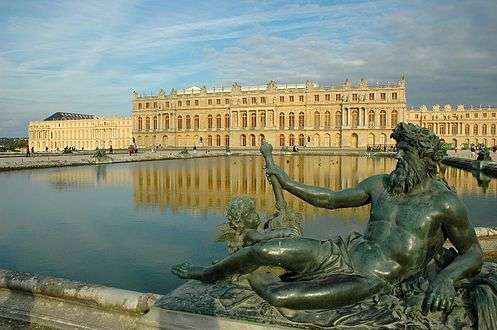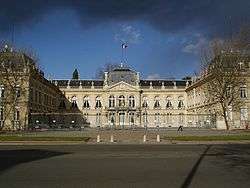Yvelines
| Yvelines | ||
|---|---|---|
| Department | ||
|
Prefecture building of the Yvelines department, in Versailles | ||
| ||
 Location of Yvelines in France | ||
| Coordinates: 48°50′N 1°55′E / 48.833°N 1.917°ECoordinates: 48°50′N 1°55′E / 48.833°N 1.917°E | ||
| Country | France | |
| Region | Île-de-France | |
| Prefecture | Versailles | |
| Subprefectures |
Mantes-la-Jolie Rambouillet Saint-Germain- en-Laye | |
| Government | ||
| • President of the General Council | Pierre Bédier | |
| Area1 | ||
| • Total | 2,284 km2 (882 sq mi) | |
| Population (2013) | ||
| • Total | 1,418,484 | |
| • Rank | 9th | |
| • Density | 620/km2 (1,600/sq mi) | |
| Time zone | CET (UTC+1) | |
| • Summer (DST) | CEST (UTC+2) | |
| Department number | 78 | |
| Arrondissements | 4 | |
| Cantons | 21 | |
| Communes | 262 | |
| ^1 French Land Register data, which exclude estuaries, and lakes, ponds, and glaciers larger than 1 km2 | ||
Yvelines (French pronunciation: [ivlin]) is a French department in the region of Île-de-France.
History
Yvelines was created from the western part of the former department of Seine-et-Oise on 1 January 1968 in accordance with a law passed on 10 January 1964 and a décret d'application (a decree specifying how a law should be enforced) from 26 February 1965. It inherited Seine-et-Oise's official number of 78.
It gained the communes of Châteaufort and Toussus-le-Noble from the adjacent department of Essonne in 1969.
The departmental capital, Versailles, which grew up around Louis XIV's château, was also the French capital for more than a century under the Ancien Régime and again between 1871 and 1879 during the early years of the Third Republic. Since then the château has continued to welcome the French Parliament when it is called upon to sit in a congressional sitting (with both houses sitting together) in order to enact constitutional changes or to listen to a formal declaration by the president.[1]
Geography
Yvelines is bordered by the departments of Val-d'Oise on the north, Hauts-de-Seine on the east, Essonne on the southeast, Eure-et-Loir on the southwest, and Eure on the west.
The eastern part of the department, as well as its northern part along the Seine, is part of the Paris metropolitan area, but the rest of the department is rural, much of it covered by the Forest of Rambouillet (also known as the Forest of Yveline, from which the name of the department is derived).
Besides Versailles (the prefecture) and the subprefectures of Mantes-la-Jolie, Rambouillet, and Saint-Germain-en-Laye, important cities include Conflans-Sainte-Honorine, Poissy, Les Mureaux, Houilles, Plaisir, Sartrouville, Chatou, Le Chesnay, and the new agglomeration community of Saint-Quentin-en-Yvelines.
Two regional parks can be found in Yvelines: the parc of the Haute Vallée de Chevreuse and part of the parc of Vexin Français.
Yvelines is home to one of France's best known golf courses, La Tuilerie-Bignon, in the village of Saint-Nom-la-Bretèche.
Principal towns
| Rank | Commune | Canton | Arrondissement | Population |
|---|---|---|---|---|
| 1 | Versailles | Versailles-1 Versailles-2 |
Versailles | 85,272 |
| 2 | Sartrouville | Sartrouville | Saint-Germain-en-Laye | 51,599 |
| 3 | Mantes-la-Jolie | Mantes-la-Jolie | Mantes-la-Jolie | 45,052 |
| 4 | Saint-Germain-en-Laye | Saint-Germain-en-Laye | Saint-Germain-en-Laye | 39,547 |
| 5 | Poissy | Poissy | Saint-Germain-en-Laye | 37,461 |
| 6 | Conflans-Sainte-Honorine | Conflans-Sainte-Honorine | Saint-Germain-en-Laye | 35,213 |
| 7 | Montigny-le-Bretonneux | Montigny-le-Bretonneux | Versailles | 33,625 |
| 8 | Houilles | Houilles | Saint-Germain-en-Laye | 32,287 |
| 9 | Les Mureaux | Les Mureaux | Mantes-la-Jolie | 31,487 |
| 10 | Plaisir | Plaisir | Versailles | 31,342 |
| 11 | Trappes | Trappes | Versailles | 20,718 |
| 12 | Chatou | Chatou | Saint-Germain-en-Laye | 30,809 |
| 13 | Le Chesnay | Le Chesnay | Versailles | 28,640 |
| 14 | Guyancourt | Montigny-le-Bretonneux | Versailles | 27,546 |
| 15 | Élancourt | Trappes | Rambouillet | 26,290 |
Demographics
In French, a man from the Yvelines is called Yvelinois (plural Yvelinois); a woman is Yvelinoise (plural Yvelinoises).
Place of birth of residents
| |||||||||||||||||||
Tourism
Palaces and châteaux
- Palace of Versailles
- Château of Breteuil
- Château of Buc
- Château of Dampierre
- Château of Maisons-Lafitte
- Château of Rambouillet
- Château of Saint-Germain-en-Laye
- Château of Thoiry
- Château of Vaux-sur-Seine
- Château of Mauvières
- Château du Pont
- Château Villette
- Château of Millemont
Museums
- Museum of National Antiques (Saint-Germain-en-Laye)
- Museum of River and Canal Craft (Conflans-Sainte-Honorine)
- Horse-drawn Coach Museum (Versailles)
- Toy Museum (Poissy)
- Sheep Museum (Rambouillet)
- Cloth Museum of Jouy (Jouy-en-Josas)
- National Barn Museum of Port-Royal (Magny-les-Hameaux)
- International Museum of Naive Art
- Musee Lambinet (Versailles)
Artists' and writers' houses
- André Derain's house (Chambourcy)
- Elsa Triolet-Aragon's house (Saint-Arnoult-en-Yvelines)
- Émile Zola's house (Médan)
- Maurice Ravel's house/museum (Montfort-l'Amaury)
- Ivan Turgenev House (Bougival)
- Alexandre Dumas, père's Château de Monte-Cristo (Port-Marly)
- Jean-Claude Richard's family estate (Saint-Nom-la-Bretèche)
Parks and gardens
- Chèvreloup Arboretum (Rocquencourt)
- Marly Estate (Marly-le-Roi)
- Vaux sur Seine Castle Garden (Vaux sur Seine)
- The King's Vegetable Garden (Versailles)
- Outdoor and entertainment base of Saint-Quentin-en-Yvelines (Trappes)

- The Grand Trianon
_(8040177482).jpg)
 The Venus of Brassempouy from the collection of the Château de Saint-Germain-en-Laye
The Venus of Brassempouy from the collection of the Château de Saint-Germain-en-Laye
Politics of Yvelines
Former Prime Minister of France Michel Rocard, was an MP for this department, of the French Socialist Party.
Senators from Yvelines
- Nicolas About (Centrist Union)
- Jacques Bellanger (Socialist Party)
- Dominique Braye (UMP)
- Alain Gournac (UMP)
- Gérard Larcher (UMP)
See also
- Cantons of the Yvelines department
- Communes of the Yvelines department
- Arrondissements of the Yvelines department
References
- ↑ "Communiqué de la présidence de la République" (in French). Retrieved 17 October 2009.
- ↑ "Insee - Populations légales 2013". Insee. Retrieved August 25, 2016.
External links
- (French) Prefecture of Yvelines
- (French) General council of Yvelines
- (French) History of Famous People and Yvelines

